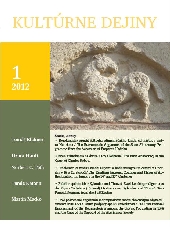Prvé pastoračné angažmán redemptoristov medzi slovenským obyvateľstvom v roku 1874 a kauza podpory spolku striezlivosti
The First Pastoral Engagement of the Redemptorists among the Slovak Population in 1874 and the Case of the Support of the Abstinence Society
Author(s): Martin MackoSubject(s): History
Published by: VERBUM - vydavateľstvo Katolíckej univerzity v Ružomberku
Keywords: Redemptorists; Abstinence Society; Brotherhood of the Rosary; Popular Missions; Diocese of Nitra
Summary/Abstract: The year 1874 represents a significant milestone in the Slovak emancipation efforts in Hungary. In that year, all three Slovak secondary grammar schools in Revúca, Turčiansky Svätý Martin and Kláštor pod Znievom were closed, and a state investigation against Matica slovenská was launched. In addition, the so called abstinence societies that had played an important role in the raising of the public awareness among the rural people of Upper Hungary since the 1840’s, were also forbidden. However, as these societies were led by nationally conscious Slovaks, they were also suspected of promoting panslavism by the Magyar state administration. There are several monographs and studies dealing with the above stated movement or its promoters. In general, they claim that a contribution of religious orders to the proliferation of the abstinence societies was quite small as compared to that of diocesan Catholic clergy, Lutheran clergy and intellectuals, and thus this topic is not so frequent. In principle, one can agree with such an argument. Nevertheless, it is this point of view that the author of the paper had decided to deal with the issue from. He did so on the basis of the first pastoral engagement of the Redemptorists (officially the Congregation of the Most Holy Redeemer) among the Slovak population which took place right in the “fatal” year 1874. In order to avoid a possible abolishment by the state apparatus, the abstinence societies largely began to integrate into brotherhoods of the rosary from the early 1870’s. As they transformed themselves from “political” associations into church societies under the aegis of a local diocesan bishop who was in this respect independent of the state authorities, they gained certain exemption. The clergy of the Nitra diocese, where such a fused society with the permission of the bishop Augustinus Roskoványi came into existence as early as in 1872, decided to support it through the popular missions in 1874. After the fall of Josephinism in 1848, these missions began to be spread on a mass scale throughout the monarchy again. To carry out this missionary tour in several parishes in the Kysuce region and in the environs of the town of Rajec, the Redemptorists of Bohemia were eventually called up. At that time, the Czech Redemptorists did not have any monastery in Hungary. Their engagement provoked an unexpectedly sharp conflict with the state authorities. On the basis of the direct intervention of the Minister of Education and Public Worship Augustine Trefort, even the bishop Roskoványi had to cancel the missions. The author traces back the course of the conflict, its reasons, the justifiability of the brought charges, the attitudes of the involved (episcopate, diocesan clergy, representatives of local governments, common people) as well as he tries to correct some clichés that have been incorrectly transferred to the present.
Journal: Kultúrne dejiny
- Issue Year: 2012
- Issue No: 1
- Page Range: 60-75
- Page Count: 16
- Language: Slovak

